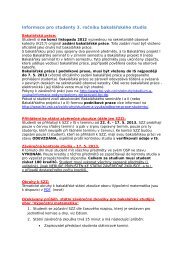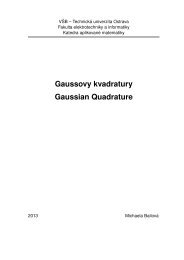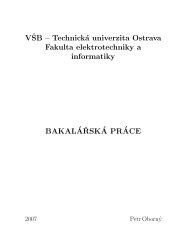Lyapunov exponents of the predator prey model Ljapunovovy ...
Lyapunov exponents of the predator prey model Ljapunovovy ...
Lyapunov exponents of the predator prey model Ljapunovovy ...
Create successful ePaper yourself
Turn your PDF publications into a flip-book with our unique Google optimized e-Paper software.
37One <strong>of</strong> <strong>the</strong> special cases <strong>of</strong> <strong>the</strong> competitive Lotka–Volterra is Sharkovskiĭ’s systemgiven byS (x, y) = (x (4 − x − y) , xy) ,where <strong>the</strong> phase space is a triangle with vertices (0, 0) , (0, 4) and (4, 0). The periodicproperties <strong>of</strong> <strong>the</strong> restriction <strong>of</strong> S to <strong>the</strong> lower side <strong>of</strong> <strong>the</strong> triangle is clear since <strong>the</strong> restrictionis equal to <strong>the</strong> Logistic map. The fixed points are Fix (S) = {(0, 0) , (1, 2) , (3, 0)}. Thepoint (x, y) = (0, 0) is a saddle point, <strong>the</strong> o<strong>the</strong>rs are repelling points. Let us now focusonly on <strong>the</strong> interior <strong>of</strong> <strong>the</strong> invariant triangle. It was proved that <strong>the</strong>re are no periodicpoints <strong>of</strong> periods 2 and 3 but for n ≥ 4 <strong>the</strong>re is periodic point <strong>of</strong> period n. The cycle<strong>of</strong> period 4 was given explicitly in [2]. Moreover authors numerically approximated <strong>the</strong>cycle <strong>of</strong> period 5. In [25] was given explicitly <strong>the</strong> cycle <strong>of</strong> period 6. The question if <strong>the</strong> set<strong>of</strong> all <strong>the</strong> interior periodic points is dense is still open (it was stated as an open problemby A. N. Sharkovskiĭ in [30]).Now <strong>the</strong> task is to research all <strong>Lyapunov</strong> <strong>exponents</strong> <strong>of</strong> <strong>the</strong> Lotka–Volterra <strong>model</strong> withrespect to relevant parameters. For this purpose we are going to use techniques introducedin <strong>the</strong> previous section. However, we are not able to use Theorem 4.1 directly sinceS is not a diffeomorphism. Fortunately it was proved in [34] that it is possible to split <strong>the</strong>phase space into regions such that S restricted to each <strong>of</strong> <strong>the</strong>m is diffeomorphism.Next, utilizing Source Code 3 one can compute <strong>Lyapunov</strong> <strong>exponents</strong>. Hence, <strong>the</strong> <strong>Lyapunov</strong><strong>exponents</strong> <strong>of</strong> Sharkovskiĭ’s system areL 1 ≈ 0.303881,L 2 ≈ −0.009527.Consequently, <strong>the</strong> Sharkovskiĭ’s <strong>model</strong> has positive maximal <strong>Lyapunov</strong> exponent thatyields chaotic pattern.Let us denote <strong>the</strong> part 4x−x 2 by g (x). It is easy to verify that g (x) is topologically conjugateto <strong>the</strong> Logistic map by conjugacy h (x) = 4x. Modifying g by parameter µ ∈ [0, 1]we get <strong>the</strong> parametric family g (x) = µx (4 − x) that corresponds to <strong>the</strong> parametric system<strong>of</strong> Logistic map F µ (x) discussed in <strong>the</strong> section Logistic family. Moreover we modify<strong>the</strong> second equation by parameter ξ ∈ [0, 1].Finally, <strong>the</strong> parametrized <strong>model</strong> that should be researched is:S µ,ξ (x, y) = (µx (4 − x) − xy, ξxy) .In Figures 15-18 are <strong>the</strong> bifurcation diagrams <strong>of</strong> S µ,ξ for fixed parameter µ. Combinedwith <strong>the</strong> Figure 19 <strong>the</strong>y show us <strong>the</strong> change <strong>of</strong> behavior from periodic or quasi-periodicto chaotic. Again see that in first two cases (parameter values µ = 0.25 and µ = 0.5) <strong>the</strong>maximal <strong>Lyapunov</strong> exponent is non-positive (for µ = 0.25 it seems to be zero but it islower than zero all <strong>the</strong> time) and it is equal to zero only in bifurcation boundaries. In <strong>the</strong>last two images we see that some values <strong>of</strong> <strong>the</strong> maximal <strong>Lyapunov</strong> <strong>exponents</strong> are positivewhich is considered as <strong>the</strong> indication <strong>of</strong> chaotic behavior <strong>of</strong> <strong>the</strong> system.









